I am going to combine two sources, Dummett in Chapter 20 of Game of Tarot and an essay published in 2012 that Bertrand steered me to almost a year ago (http://forum.tarothistory.com/viewtopic ... gio#p13783).
Dummett argues that the Marseille pattern probably came from Milan around the same time as the Cary Sheet and the earliest Sforza Castle cards. First, he observes the well-known similarities between the Cary Sheet and the Marseille pattern. I am aware that Dummett's thesis about the Cary Sheet's origin has been questioned, but after re-reading the "Cary Sheet Again" thread at http://forum.tarothistory.com/viewtopic.php?f=14&t=566 I see no reason to do so.
Then Dummett turns to the Sforza Castle cards, with their famous 2 of Coins dated "1499" (Game of Tarot p. 409). For pictures of this and other Sforza Castle cards, go to http://forum.tarothistory.com/viewtopic.php?f=14&t=802.
On the one hand, there is no reason to think the 2 of Coins belonged to a Tarot pack; on the other hand, it would appear that at least the style of the Tarot de Marseille number cards came from Milan.The most interesting of all the cards found at the Castello is a 2 of Coins which bears the scroll in the shape of an inverted S which, in Chapter 9, we.noted as always occurring (sometimes not inverted) in Tarot de Marseille packs, and also in the pack of Jacques Vievil. As on the French cards, the scroll is inscribed with the maker's name and the date; the inscription reads PAVLINVS [DE] CASTELETO FECIT 1499. Novati cites documentary evidence of the presence in Milan in 1508 and 1513 of a cardmaker by the name of Paolino di Castelletto. There is no reason to regard Paolino's 2 of Coins, any more than the other cards just discussed, as having belonged to a Tarot pack: it nevertheless provides good evidence that a distinctive feature of French and Swiss Tarot card design was borrowed from Milan.
He notices also that although there is no 2 of cups there, the Marseille design nonetheless as an ancient feature, the "dragon-head", which he says is similar to the dragon-heads on the "polo stick" suit of a certain Mamluk deck. He concludes:
He notes also that the other number cards, although of a variety of times, look very similar in style to the 2 of Coins. And although some of the court cards are of a different style, their kings and the jack of batons nonetheless have the wide-brimmed hat associated with these cards (and the Bateleur) of the Tarot de Marseille. He concludes:if so, the design of at least that particular card must go back to a period when Islamic cards were familiar to European players or cardmakers. This, too, fits very well with our conclusion that the designs on which the Tarot de Marseille was based were ones used in Milan, the birthplace of that Valentina Visconti whose inventory, upon her death in 1408, had listed ung jeu de quartes sarrasines along with unes quartes de Lombardie.(25)
What the Cary sheet and the Castello Sforzesco cards make clear is that, in adopting a form of pack derived from the Tarot de Marseille, the players of tarocchi in Lombardy were welcoming home a descendant of the type of pack with which their ancestors had played, and a close relative of that used by their fathers.
Regarding court cards, it seems to me that Dummett's case is strengthened by some cards shown by Roger Tilley in his book Playing Cards, 1967, p. 2. which he dates, on p.27, to 1530 Milan.
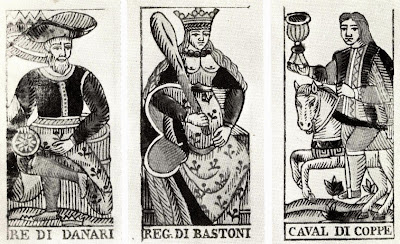
I seem to remember that some have argued, perhaps including Depaulis, that the Tarot de Marseille style is too late to be Italian c. 1500. However the essay, "Un gioco tra profezia e filosofia: i tarocchi di Marsilio" by Christophe Poncet (in Linguuagi degli Cielo, 2012, pp. 254-269) compares Baldini's "prophets and sybils" series with certain Marseille trumps. This of course is Florence rather than Milan. Poncet starts out (I give the Italian first, then my attempt at a translation):
First is the Pope. After my English version, I give his illustration, table 3:Tra i ventidue trionfi dei tarocchi di Marsiglia, cinque presentano somiglianze straordinàrie con alcune immagini della serie dei profeti e delle sibille di Baldini o di altre stampe create nella stessa cerchia d'incisori fiorentini: la Papessa, il Papa, l'Imperatrice, l'Imperatore e la Giustizia.
(Among the twenty-two trumps of the Tarot of Marseilles, five have similarities with some extraordinary images of the series of prophets and sibyls of Baldini or other prints created in the same circle of Florentine engravers: the Popess, the Pope, the Empress, the Emperor and Justice.)
Il Papa (TAV. 1) è disegnato secondo lo stesso modello del profeta Baruc (TAV. 2): stessa posizione seduta, con il corpo in posizione frontale e la faccia di tre quarti, stesso tipo di mantello lungo; i lineamenti dei volti sono assai simili, in particolare il taglio della barba e dei baffi, la bocca, il mento e il naso. Inoltre, anche alcune differenze testimoniano che una figura dipende dall'altra: se, per esempio, i copricapi sono di specie diverse (una tiara per il papa, un berretto per il profeta), tutti e due sono sormontati da un bottone rotondo che„in entrambi i casi, è allineato esattamente sotto il [262] lato superiore della cornice. Anche le mani si corrispondono: la destra del papa imita, in modo invertito, il gesto della sinistra di Baruc; le altre due mani sembrano riflettersi l'ima nell'altra. Le similitudini sono tali che le mani dei due personaggi possono venire scambiate (TAV. 3).
(The Pope (Table 1) is designed according to the model of the prophet Baruch (Table 2): the same sitting position, with the body in front and side in three quarters, the same type of long coat, the features of the faces are very similar, especially the cutting of the beard and mustache, mouth, chin and nose. In addition, some differences show that one figure depends on the other: if, for example, the headpieces are of different species (a tiara for the pope, a cap for the Prophet), both are surmounted by a round button that in both cases is aligned exactly under the the upper side of the frame. Even the hands correspond to each other: the right of the Pope imitates, in reverse, the gesture of the left of Baruch, the other two hands appear to be reflected each in the other. The similarities are such that the hands of the two characters can be exchanged (Table 3).

Anche la Papessa (TAV. 4) mostra un aspetto senza dubbio ripreso dalla serie di Baldini. In generale, la sua posa, l'essere seduta e di tre quarti, è simile a quella del profeta Abacuc (TAV. 5 sopra); tutti e due tengono un libro in grembo, e colpisce la similitudine delle braccia sinistre, vestite della stessa manica orlata che emerge da una„analoga falda del mantello. Alcuni particolari della Papessa si ritrovano in un'altra figura, quella della sibilla Libica, che condivide anche lei la stessa posa, con un libro nelle mani (TAV. 5 sotto). Ma questa volta le corrispondensee più notevoli appaiono dall'altro lato, alla sua destra, nel particolare della piega del mantello sotto la quale si rivela il libro aperto. Anche i tratti dei volti si somigliano: gli occhi cerchiati, le linee del naso e della bocca, la fossetta sul mento. Per di più, i copricapi, benché diversi, condividono la particolarità di essere conici e prolungati da un velo. Perciò la Papessa sembra_essere composta con il lato sinistro di Abacuc e il lato destro della sibilla Libica.
(The Popess (Table 4) also shows an aspect no doubt taken from the series by Baldini. In general, her pose, being seated and in three quarters, is similar to that of the prophet Habakkuk (Table 5 above), both hold a book in their lap, which affects the similarity of their left arms, dressed in the same hemmed sleeve that emerges from a similar flap of the coat. Some details of the Popess can be found in another figure, that of the Libyan Sibyl, who also shares the same pose, with a book in her hands (Table 5 below). But this time the most significant correspondences appear on the other side, to her right, in particular the fold of the mantle under which reveals her open book. Even the facial features are similar: the rimmed eyes, the lines of the nose and mouth, the dimple on the chin. Moreover, the headpieces, although different, share the distinction of being conical and extended further by a veil. Therefore, the Popess seems to be composed of the left side of Habakkuk and the right side of the Libyan Sibyl.)
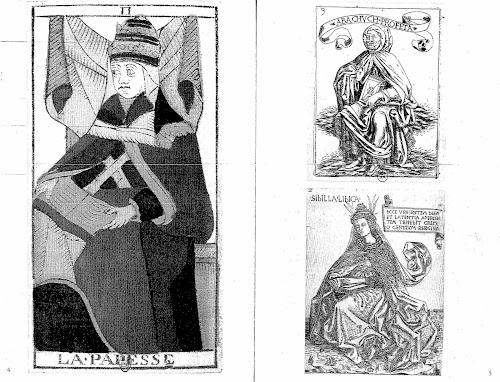
L'Imperatore (TAV. 6) sembra risultare dalla combinazione di due profeti. Da Eliseo riprende lo schema generale: la posizione seduta e la testa di profilo, ma anche il movimento delle braccia, i tratti del volto e il disegno dei capelli, in quanto un ricciolo è stato trasformato nella parte del copricapo che ricopre la tempia (TAV. 7 sopra). La spirale che si vede all'estremità della bandiera tenuta da Eliseo è stata riutilizzata nella stessa posizione, sotto la mano, come motivo decorativo sul bracciolo del seggio imperiale. Da un altro profeta, Giosuè, l'Imperatore riprende il viso, ma da questo bulino viene recuperato anche un elemento architettonico che orna il palazzo, il quale, un po' modificato, è divenuto la spalliera del trono (TAV. 7 sotto).
(The Emperor (Table 6) seems to result from the combination of two prophets.From Elisha the general pattern is taken: the sitting position and the head in profile, but also the movement of the arms, facial features and hair design, as a curl has been transformed into the part of the headgear that covers the temple (Table 7 above). The spiral that you see at the end of the banner held by Elisha has been reused in the same position under the hand, as a decorative motif on the arm of the imperial throne. From another prophet, Joshua, the Emperor has taken his face, but this burinhas also recovered an architectural element that adorns the palace, which, little changed, has become the back of the throne (Table 7 below).)
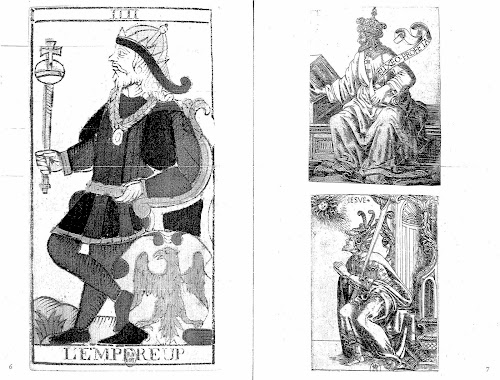
Nella Giustizia dei tarocchi (TAV. 8), il principale prestito dalla serie di Baldini è la postura della sibilla Eritrea: stessa posizione frontale, con una spada nella mano destra, il pomello tenuto sul ginocchio; simile il movimento del braccio sinistro, con la mano all'altezza del cuore (TAV. 9). Le due figure condividono anche alcuni particolari: il collare plissettato, l'arco della cintura, il movimento del drappeggio sulle gambe.
(In the tarot Justice (Table 8), the principal loan from the series by Baldini is the posture of the Eritrean Sibyl: the same frontal position, with a sword in her right hand, the knob held on the knee; similar is the movement of the left arm, with the hand at heart level (Table 9).The two figures also share some details: the pleated collar, the arc of the belt, the movement of the drapery on the legs.)
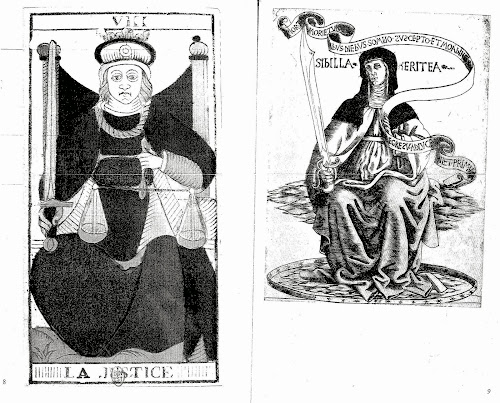
Se la figura dell'Imperatrice (TAV. 10) condivide un'aria di famiglia con alcune sibille, risulta difficile evidenziare prestiti precisi, mentre colpiscono di più le somiglianze con un niello, realizzato da Maso Finiguerra, orefice e incisore fiorentino maestro di Baldini (TAV. 11). L'immagine rap-[263] presenta una figura femminile seduta tra gli angeli, generalmente indicata dagli storici dell'arte come la Giustizia (Blum, 1950, p. xvii; Goldsmith Phillips, 1955, p. 13 e ivi la fig. IIA). La posizione generale è la stessa, il corpo frontale con la testa di tre quarti. I gesti delle braccia sono simili ma diversi sono gli oggetti tenuti in mano. Infatti, il disegnatore sembra aver giocato con gli elementi forniti dalla cosiddetta "Giustizia" per creare quelli dell'Imperatrice. Assembla dunque la spada e il globo della prima per formare lo scèttro della seconda, e reimpiega uno scudo presentato da due piccoli orsi, mettendolo sotto il braccio dell'Imperatrice. È anche da notare l'ovvia somiglianza tra i gesti delle mani. Stranamente, un'ala simile a quelle degli angeli del niello sporge sotto la coscia sinistra dell'Imperatrice.
La figura del niello è considerata una rappresentazione della Giustizia per le sue analogie con un quadro più tardo di Piero Pollaiolo che rappresenta questo stesso soggetto (Poletti, 2001, pp. 187-95); ma le similitudini formali non inducono necessariamente l'identità dei temi. Alcuni particolari del niello infatti si riflettono anche nell’ incisione della sibbìla Eritrea di Baldini (TAV. 9): la posizione generale, la plissettatura della camicia sotto la cintura, il movimento del drappeggio sulle gambe, il disegno delle nuvole sulle quali le figure femminili sono sedute. Inoltre, lo scudo del niello sorretto dagli orsi è quello degli Orsini, la famiglia del cardinale che aveva fatto raffigurare le dodici sibille. In un manoscritto che descrive la famosa serie dipinta nel suo palazzo romano, si legge che «il cardinale degli Orsini abbia fatto raffigurare un orso sotto i piedi della prima sibilla» Hélin, 1936, pp. 359-60). Se consideriamo questi indizi convergenti (orsi, scudo della famiglia Orsini, analogie con la sibilla di Baldini), possiamo supporre che il niello sia una prima testimonianza grafica della serie di figure che decorava il palazzo Orsini.
(If the figure of the Empress (Table 10) shares a family resemblance with some sibyls, it is difficult to highlight specific loans, while effecting more similarities with a niello made by Maso Finiguerra, Florentine goldsmith and engraver, Baldini’s master (Table 9). The image, generally indicated by art historians as Justice (Blum, 1950, p. xvii; Goldsmith Phillips, 1955, p. 13 and Fig. IIA there), repre-[263]sents a seated female figure between angels. The general position is the same, the body in front with the head in three quarters. The gestures of the arms are similar but there are different objects held in the hands. In fact, the designer seems to have played with the elements provided by the so-called "Justice" to create those of the Empress. He assembles, therefore, the sword and the globe of the first so as to form the scepter of the second and reuses into a shield what is presented by two little bears, putting it under the Empress’s arm. Also of note is the obvious similarity between the hand gestures. Strangely, a wing like those of the angels of the niello protrudes below the left thigh of the Empress.
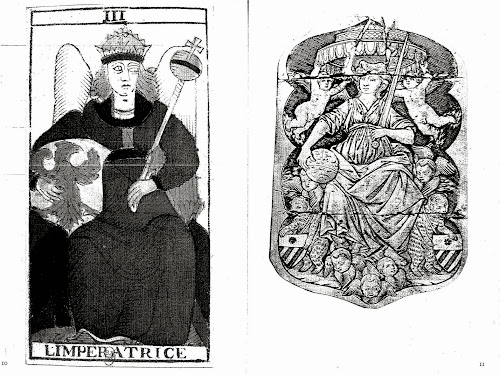
And his conclusion:The figure in niello is considered a representation of Justice, for its similarities with a clearer picture of the late Piero Pollaiuolo representing this same topic (Poletti, 2001, pp. 187-95), but the formal similarities do not necessarily lead to the identity of the subjects. Some details in fact of the niello are reflected also in the engraving of the Eritrean sibyl of Baldini (Table 9): the general position, the pleated blouse below the belt, the movement of the drapery on the legs, the design of the clouds on which the female figures are sitting. In addition, the shield of the niello supported by the bears is that of the Orsini, the family of the cardinal who had depicted the twelve sibyls. A manuscript that describes thefamous series of paintings in his palace in Rome states that “the cardinal Orsini depicted a bear under the feet of the first sibyl” (Hélin 1936, p. 359-60). If we consider these convergent indications (bears [orsi], shield of the Orsini family, analogies with the sibyl of Baldini), we can assume that the niello is a graphic testimony to the first series of figures that decorated the Palazzio Orsini.
I am not concerned with the rest of the essay, in which Poncet tries to connect the tarot with Ficino. But in what I have quoted, it seems to me that Poncet has demonstrated the visual similarities very well. I would not conclude that Baldini was the engraver of the Marseille II cards, but rather that he or someone using his designs might well have been. The style remains Florentine of the 1470s, but that does not prevent a Florentine artist using copies of Baldini's work in Milan. So I see nothing to indicate anything stylistically later than Northern Italian c. 1500 or a little later for any of the TdM2 cards..La Papessa, il Papa, l'Imperatrice, l'Imperatore, la Giustizia: questi trionfi dei tarocchi di Marsiglia costituiscono dunque un insieme coerente; quanto all'aspetto formale, sono stati tutti disegnati nella medesima cerchia di incisori e gioiellieri fiorentini e risalgono agli anni sessanta del Quattrocento; quanto all'ispirazione, derivano da figure di profeti biblici e di sibille che illustrano concetti astrologici. Possiamo anche osservare che costituiscono due coppie: il Papa e la Papessa l'uno di fronte all'altra, mentre l'Imperatore e l'Imperatrice si guardano. Isolata è invece la Giustizia, che si presenta di prospetto. In apparenza, le sibille e i profeti sono stati raffigurati quali personaggi emblematici della società medievale e rinascimentale. Come vedremo la loro vera identità è tutt'altra.
(The Popess, the Pope, the Empress, the Emperor, Justice: these trumps of the Tarot of Marseilles, therefore, constitute a coherent whole. As to their formal aspect, they were all drawn in the same circle of engravers and goldsmiths in Florence and date back to the sixties of the 15th century; for inspiration they are derived from the figures of the biblical prophets and sibyls that illustrate astrological concepts. We can also observe which form two pairs: the Pope and the Popess facing one another, while the Emperor and Empress guard themselves. Instead, Justice is isolated, and she presents, in appearance, its prospect. The sibyls and prophets were depicted as emblematic of medieval and Renaissance society. As we will see their true identity is quite another.)
I also cannot see why the so-called "TdM2" is judged later than the "TdM1" (the Noblet etc.), other than the fact that the earliest surviving TdM2 is later than the earliest surviving TdM2. But we really have no idea when these patterns were first implemented. The court cards from Tilley look to me like TdM1. The Baldini engravings look to me like TdM2. I don't see why they couldn't have been two variants that co-existed in Northern Italy by the early 16th century. From the primitiveness of the TdM1 designs I do not conclude that it was earlier, but merely that the artist was less skilled, or perhaps wanted the cards to appear of a more ancient design than the other.
There is also the question of whether the Tarot de Marseille pattern might be even earlier than the 1460s. We know that the engravings of the Triumphs came considerably after similar depictions on cassoni. The model for Baldini's engravings of the prophets and sibyls was the series in the Orsini palace in Rome of shortly before 1432, which is where the 11th and 12th sibyls originate, via extant descriptions of them if not visual representations now lost. Zucker, in his discussion of the engravings (Illustrated Bartsch vol. 24 Part 1, p. 161), says:
This does not exclude, unfortunately, models that bear the same relationship to these engravings as the cassoni paintings do to the engraved Triumphs..Zucker notes that besides the Florentine style, Northern European models are also evident in "slightly less than half" of the engravings,"possibly French or Burgundian" and clearly German. This point, of course, needs to be kept in mind in relation to the Cary Sheet, too.The majority of his figures are conceived entirely in the spirit of such contemporary Florentine painters as Verrocchio, the Polliauolo brothers, and the young Botticelli. Paintings executed by these artists ca. 1470-75 (e.g. the well-known panels of the "Seven Virtues" by Piero Pollaiuolo and Botticelli) seem to offer the nearest analogies to the engravings.

